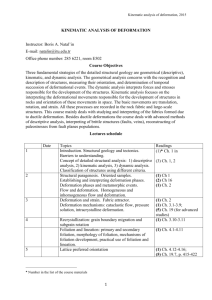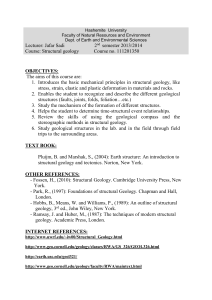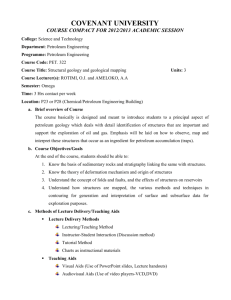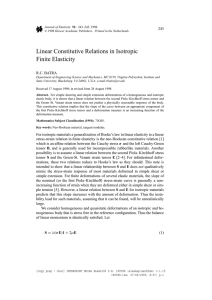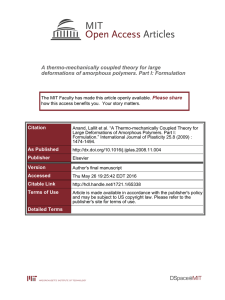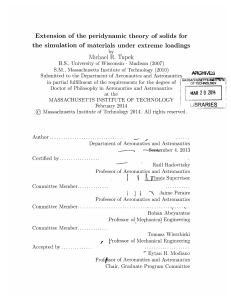Quantitative Structural Analysis: Where does it start?
advertisement
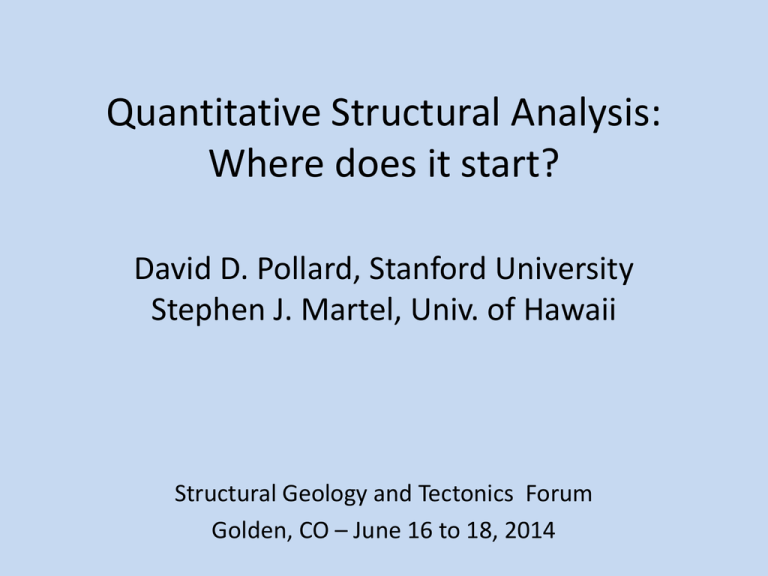
Quantitative Structural Analysis: Where does it start? David D. Pollard, Stanford University Stephen J. Martel, Univ. of Hawaii Structural Geology and Tectonics Forum Golden, CO – June 16 to 18, 2014 Objectives • Introduce a new way to teach undergraduate structural geology – Make the foundational concepts accessible – Integrate teaching, research and practice – Unite all aspects of structural geology – Prepare students for professional work • Recruit help for testing the new textbook There are many good textbooks Change may not be easy… Why is a new book needed? • Suppose you asked your students this after completing the structure course : What are the foundational concepts that underlie all tectonic processes and their structural products? • Would truly meaningful answers emerge? A meaningful answer • Identifies the glue to integrate field work, lab testing, modeling, and theory • Connects geometry, kinematics, constitutive laws, stress states, and boundary conditions • Informs students how to study the natural complexity of rock deformation • Ties structural geology to related disciplines (e.g. geophysics, rock mechanics, engineering geology, civil engineering) Foundational concepts • Conservation of – mass – momentum – energy The conservation laws underlie all tectonic processes and their structural products. Here, we focus on mass and momentum Cauchy’s first law of motion • Quantifies conservation of mass & momentum Dv i ji gi Dt x j • This law plays a central role in field work, lab experiments, and modeling • Tectonic processes are conservative ma F • The only equation of this talk… Independent variables: Coordinates Dv i ji gi Dt x j Referential Descriptions of motion Spatial Independent variable: Time Dv i ji gi Dt x j Relative age Geochronology Rate Dependent variables: Velocity, Stress • Stress analysis and kinematic analysis do not stand alone, but are inextricably linked by the equation of motion Dv i ji gi Dt x j • These variables are associated as the ‘effect’ and ‘cause’ of deformation Accommodates the natural complexity of geologic structures • Deformation varies spatially Dv i ji gi Dt x j • Deformation varies temporally Dv i ji gi Dt x j • Partial derivatives are essential Boundary conditions at the outcrop It looks like these curved faults opened when they slipped. We should use ‘contact’ boundary conditions. Photo of Dave and Steve, Bear Creek, Balloon overhead with Cauchy’s eq. Dv i ji gi Dt x j Universal value Dv i ji gi Dt x j • All relevant constitutive properties of rock – brittle elastic, ductile plastic, viscous, … • All relevant rates of deformation – quasi-static to dynamic • All relevant magnitudes of strain – infinitesimal to finite • All relevant length scales – nm to crustal • All relevant time scales – ms to Ma Putting the equations of motion to use • Too many dependent variables… vi (3) ij (6) Dv i ji gi Dt x j • Choose a constitutive law and reduce the number of variables • Choose the appropriate kinematic relations Example 1 • Hooke’s Law for linear elasticity and small strain kinematics • Navier’s equations of motion for solid mechanics • Applications: fractures, faults, dikes… – Elastic brittle deformation Sheeting joints Martel , S.J., 2011, Geophys. Res. Ltrs., v. 38, p. L20303 (photo by Greg Stock) Example 2 • Stoke’s Law for linear viscosity and rate of deformation kinematics • Navier-Stokes equations of motion for fluid mechanics • Applications: folding, magmatic intrusions, salt tectonics… Buckle folds Hudleston, P.J. & Treagus, S.H., 2010, J. Structural Geology, v. 32, p. 2042 Example 3 • Von Mises yield criterion • FEM analysis for elasto-plasticity • Applications: folding, shear zones, fabrics… – elastic-ductile deformation Localized mylonitic foliation Nevitt, J.M., Pollard, D.D., & Warren, J.M., 2014, J. Structural Geology, v. 60, p. 55-69 Summary • Cauchy’s equations of motion provide a much needed universal and foundational concept for undergrad students of structural geology. • Teaching from this foundation builds on the pre-requisite courses in the undergrad curriculum, particularly calculus and physics. Summary • Teaching from this foundation makes it clear why one should choose a constitutive law and not divorce kinematic and dynamic variables. • Teaching from this foundation makes it clear that deformation varies in space and time, and provides the tools (partial derivatives) for analyzing the relevant field quantities. Will you help us? • If you would like to be a member of the testing team for the new book, please contact: dpollard@stanford.edu Testing constitutive laws Nevitt, J.M., PhD Thesis, 2014 Testing constitutive laws Von Mises Drucker-Prager Power-law creep Constrained viscoplastic Viscoplastic w/ relaxation Viscoplastic w/ more relaxation Nevitt, J.M., PhD Thesis, 2014 Earthquake faulting 1999 Hector mine earthquake (Mw 7.1), southern California InSAR data Elastic model Maerten, F., et. al., 2005, B.S.S.A., v. 95, p. 1654 Volcanic eruption Curtain of fire, Kilauea



